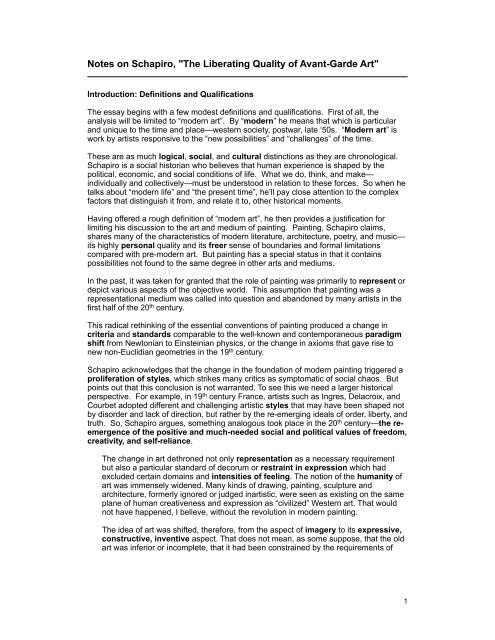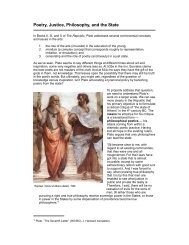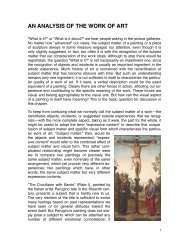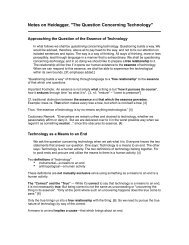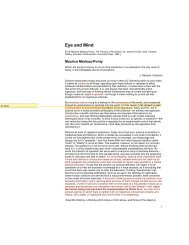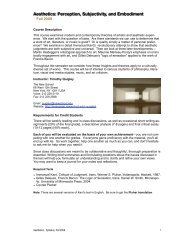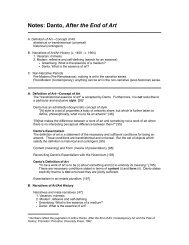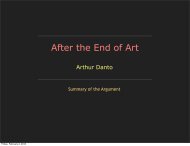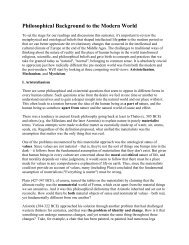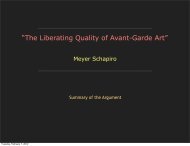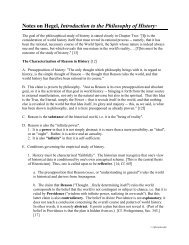Notes on Schapiro, "The Liberating Quality of Avant-Garde Art"
Notes on Schapiro, "The Liberating Quality of Avant-Garde Art"
Notes on Schapiro, "The Liberating Quality of Avant-Garde Art"
Create successful ePaper yourself
Turn your PDF publications into a flip-book with our unique Google optimized e-Paper software.
<str<strong>on</strong>g>Notes</str<strong>on</strong>g> <strong>on</strong> <strong>Schapiro</strong>, "<strong>The</strong> <strong>Liberating</strong> <strong>Quality</strong> <strong>of</strong> <strong>Avant</strong>-<strong>Garde</strong> Art"Introducti<strong>on</strong>: Definiti<strong>on</strong>s and Qualificati<strong>on</strong>s<strong>The</strong> essay begins with a few modest definiti<strong>on</strong>s and qualificati<strong>on</strong>s. First <strong>of</strong> all, theanalysis will be limited to “modern art”. By “modern” he means that which is particularand unique to the time and place—western society, postwar, late ‘50s. “Modern art” iswork by artists resp<strong>on</strong>sive to the “new possibilities” and “challenges” <strong>of</strong> the time.<strong>The</strong>se are as much logical, social, and cultural distincti<strong>on</strong>s as they are chr<strong>on</strong>ological.<strong>Schapiro</strong> is a social historian who believes that human experience is shaped by thepolitical, ec<strong>on</strong>omic, and social c<strong>on</strong>diti<strong>on</strong>s <strong>of</strong> life. What we do, think, and make—individually and collectively—must be understood in relati<strong>on</strong> to these forces. So when hetalks about “modern life” and “the present time”, he’ll pay close attenti<strong>on</strong> to the complexfactors that distinguish it from, and relate it to, other historical moments.Having <strong>of</strong>fered a rough definiti<strong>on</strong> <strong>of</strong> “modern art”, he then provides a justificati<strong>on</strong> forlimiting his discussi<strong>on</strong> to the art and medium <strong>of</strong> painting. Painting, <strong>Schapiro</strong> claims,shares many <strong>of</strong> the characteristics <strong>of</strong> modern literature, architecture, poetry, and music—its highly pers<strong>on</strong>al quality and its freer sense <strong>of</strong> boundaries and formal limitati<strong>on</strong>scompared with pre-modern art. But painting has a special status in that it c<strong>on</strong>tainspossibilities not found to the same degree in other arts and mediums.In the past, it was taken for granted that the role <strong>of</strong> painting was primarily to represent ordepict various aspects <strong>of</strong> the objective world. This assumpti<strong>on</strong> that painting was arepresentati<strong>on</strong>al medium was called into questi<strong>on</strong> and aband<strong>on</strong>ed by many artists in thefirst half <strong>of</strong> the 20 th century.This radical rethinking <strong>of</strong> the essential c<strong>on</strong>venti<strong>on</strong>s <strong>of</strong> painting produced a change incriteria and standards comparable to the well-known and c<strong>on</strong>temporaneous paradigmshift from Newt<strong>on</strong>ian to Einsteinian physics, or the change in axioms that gave rise t<strong>on</strong>ew n<strong>on</strong>-Euclidian geometries in the 19 th century.<strong>Schapiro</strong> acknowledges that the change in the foundati<strong>on</strong> <strong>of</strong> modern painting triggered aproliferati<strong>on</strong> <strong>of</strong> styles, which strikes many critics as symptomatic <strong>of</strong> social chaos. Butpoints out that this c<strong>on</strong>clusi<strong>on</strong> is not warranted. To see this we need a larger historicalperspective. For example, in 19 th century France, artists such as Ingres, Delacroix, andCourbet adopted different and challenging artistic styles that may have been shaped notby disorder and lack <strong>of</strong> directi<strong>on</strong>, but rather by the re-emerging ideals <strong>of</strong> order, liberty, andtruth. So, <strong>Schapiro</strong> argues, something analogous took place in the 20 th century—the reemergence<strong>of</strong> the positive and much-needed social and political values <strong>of</strong> freedom,creativity, and self-reliance.<strong>The</strong> change in art dethr<strong>on</strong>ed not <strong>on</strong>ly representati<strong>on</strong> as a necessary requirementbut also a particular standard <strong>of</strong> decorum or restraint in expressi<strong>on</strong> which hadexcluded certain domains and intensities <strong>of</strong> feeling. <strong>The</strong> noti<strong>on</strong> <strong>of</strong> the humanity <strong>of</strong>art was immensely widened. Many kinds <strong>of</strong> drawing, painting, sculpture andarchitecture, formerly ignored or judged inartistic, were seen as existing <strong>on</strong> the sameplane <strong>of</strong> human creativeness and expressi<strong>on</strong> as “civilized” Western art. That wouldnot have happened, I believe, without the revoluti<strong>on</strong> in modern painting.<strong>The</strong> idea <strong>of</strong> art was shifted, therefore, from the aspect <strong>of</strong> imagery to its expressive,c<strong>on</strong>structive, inventive aspect. That does not mean, as some suppose, that the oldart was inferior or incomplete, that it had been c<strong>on</strong>strained by the requirements <strong>of</strong>1
epresentati<strong>on</strong>, but rather that a new liberty had been introduced which had, as <strong>on</strong>e<strong>of</strong> its c<strong>on</strong>sequences, a greater range in the appreciati<strong>on</strong> and experience <strong>of</strong> forms. 1<strong>The</strong> emphasis <strong>on</strong> freedom and faith in the "self-sufficiency <strong>of</strong> forms and colors" took holdand shaped the most inventive and forward-looking work throughout the 1940s and '50s.It also challenged and critiqued established understandings <strong>of</strong> art and its expressivepotential.Abstracti<strong>on</strong> implies...a criticism <strong>of</strong> the accepted c<strong>on</strong>tents <strong>of</strong> the precedingrepresentati<strong>on</strong>s as ideal values or life interests. This does not mean that painters, ingiving up landscape, no l<strong>on</strong>ger enjoy nature; but they do not believe, as did thepoets, the philosophers and painters <strong>of</strong> the nineteenth century, that nature can serveas a model <strong>of</strong> harm<strong>on</strong>y for man, nor do they feel that the experience <strong>of</strong> nature’smoods is an exalting value <strong>on</strong> which to found an adequate philosophy <strong>of</strong> life. Newproblems, situati<strong>on</strong>s and experiences <strong>of</strong> greater import have emerged: the challenge<strong>of</strong> social c<strong>on</strong>flict and development, the explorati<strong>on</strong> <strong>of</strong> the self, the discovery <strong>of</strong> itshidden motivati<strong>on</strong>s and processes, the advance <strong>of</strong> human creativeness in scienceand technology.All these factors should he taken into account in judging the significance <strong>of</strong> thechange in painting and sculpture. It was not a simple studio experiment or anintellectual play with ideas and with paint; it was related to a broader and deeperreacti<strong>on</strong> to basic elements <strong>of</strong> comm<strong>on</strong> experience and the c<strong>on</strong>cept <strong>of</strong> humanity, as itdeveloped under new c<strong>on</strong>diti<strong>on</strong>s.<strong>Schapiro</strong> defends individualism and the handmade quality <strong>of</strong> painting against thehomogenizati<strong>on</strong> <strong>on</strong>e finds in mass-produced objects and the numbing effects <strong>of</strong> workthat flows not from <strong>on</strong>e's intrinsic needs and interests, but is imposed by the desires andinterests <strong>of</strong> others.This art is deeply rooted, I believe, in the self and its relati<strong>on</strong> to the surroundingworld. And the pathos <strong>of</strong> the reducti<strong>on</strong> or fragility <strong>of</strong> the self within a culture thatbecomes increasingly organized through industry, ec<strong>on</strong>omy and the state intensifiesthe desire <strong>of</strong> the artist to create forms that will manifest his liberty in this striking way—a liberty that, in the best works, is associated with a sentiment <strong>of</strong> harm<strong>on</strong>y, andthe opposite stability, and even impers<strong>on</strong>ality through the power <strong>of</strong> painting touniversalize itself in the perfecti<strong>on</strong> <strong>of</strong> its form and to reach out into comm<strong>on</strong> life. Itbecomes then a possessi<strong>on</strong> <strong>of</strong> every<strong>on</strong>e and is related to everyday experience.Notice the way <strong>Schapiro</strong> appeals to a populist value in avant-garde art—it reaches "outinto comm<strong>on</strong> life", he claims, and bel<strong>on</strong>gs to every<strong>on</strong>e. This is a utopian moment in<strong>Schapiro</strong>'s essay, but <strong>on</strong>e that reaches for an ideal and attempts to go bey<strong>on</strong>d what<strong>of</strong>fends so many as blatant elitism in Clement Greenberg's writings. Greenberg, in thatsense, is not at all utopian, but <strong>of</strong>ten seems to assume an unbridgeable gap betweenthose fortunate enough to have been educated in art and those whose circumstances inlife make it impossible. So it appears their assumpti<strong>on</strong>s may diverge <strong>on</strong> this issue.<strong>Schapiro</strong> goes <strong>on</strong> to argue that avant-garde art is radically distinct from mass mediasince its emphasis is not <strong>on</strong> communicating ideas but rather <strong>on</strong> expressive form andc<strong>on</strong>templati<strong>on</strong>.<strong>The</strong> artist does not wish to create a work in which he transmits an already preparedand complete message to a relatively indifferent and impers<strong>on</strong>al receiver. <strong>The</strong> painteraims rather at such a quality <strong>of</strong> the whole that, unless you achieve the proper set <strong>of</strong>mind and feeling towards it, you will not experience anything <strong>of</strong> it at all.1 All quotes are taken from Meyer <strong>Schapiro</strong>, “<strong>The</strong> <strong>Liberating</strong> <strong>Quality</strong> <strong>of</strong> <strong>Avant</strong>-<strong>Garde</strong> Art”, Art News(Summer 1957), emphases added.2
But here's where his argument comes back to Greenberg and avant-garde art's need foran educated audience.Only a mind opened to the qualities <strong>of</strong> things, with a habit <strong>of</strong> discriminati<strong>on</strong>,sensitized by experience and resp<strong>on</strong>sive to new forms and ideas, will be preparedfor the enjoyment <strong>of</strong> this art.Timothy Quigley, 5 Feb 103


